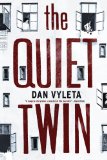Summary | Excerpt | Reading Guide | Reviews | Beyond the Book | Read-Alikes | Genres & Themes | Author Bio

 Book Reviewed by:
Book Reviewed by:
Mark James
Buy This Book
This article relates to The Quiet Twin
In 1938, the Nazis annexed Austria in what is known as the Anschluss, the "link-up" or "union". In their pursuit of a "pure" Aryan master race, they immediately began arresting anyone of difference or who might oppose them, especially Jews. According to the Vienna City Administration website, Nazi-incited pogroms in November 1938 essentially obliterated Jewish culture in Vienna.
When Dan Vyleta's The Quiet Twin begins, most of Vienna's Jews had already been deported or had fled. In one scene, he leads the reader through an abandoned house; the Jewish owners had "left... gone since winter." The edifice is an apocalyptic urbanscape with "broken windows and shattered light bulbs, angry slogans scrawled across the floor." The main character, Dr. Beer, remembers that the neighbors were the "same people who had witnessed the windows being smashed and the symbols being daubed, and done nothing about it. People like him." The vandalism and fire leave their mark on the vacant building, and the epiphany of his complicity leaves its mark on his psyche.
 In the story, Vyleta explores the lesser-known persecution of people with disabilities and homosexuals during WWII and populates his story with a variety of characters who do not fit the Nazi definition of purity. In accordance with Hitler's "Final Solution" plan, people with disabilities were targeted as part of a public health policy that sought to exclude "hereditarily unfit" people from society. The Law for the Prevention of Progeny with Hereditary Diseases in 1933 stated that medical personnel were required to report on infants less than 3 years old who exhibited "signs of severe mental or physical disability." Methods of ethnic cleansing ranged from forced sterilization to a euthanasia program code-named "T-4" for the address of the program's headquarters in Berlin, Tiergartenstrasse 4.
In the story, Vyleta explores the lesser-known persecution of people with disabilities and homosexuals during WWII and populates his story with a variety of characters who do not fit the Nazi definition of purity. In accordance with Hitler's "Final Solution" plan, people with disabilities were targeted as part of a public health policy that sought to exclude "hereditarily unfit" people from society. The Law for the Prevention of Progeny with Hereditary Diseases in 1933 stated that medical personnel were required to report on infants less than 3 years old who exhibited "signs of severe mental or physical disability." Methods of ethnic cleansing ranged from forced sterilization to a euthanasia program code-named "T-4" for the address of the program's headquarters in Berlin, Tiergartenstrasse 4.
 Homosexuals were also targeted and, as described in The Quiet Twin, went to great lengths to hide their "impure" lifestyle for fear of reprisal. Oppression of homosexuals in Germany was nothing new. According to the US Holocaust Memorial Museum website, "Under Paragraph 175 of the criminal code, male homosexuality was illegal in Germany. The Nazis arrested an estimated 100,000 homosexual men, 50,000 of whom were imprisoned." The homophobic Führer believed that homosexuals "carried a 'degeneracy' that threatened the 'disciplined masculinity' of Germany." They were denounced as "antisocial parasites" and as "enemies of the state." Many were institutionalized in mental hospitals or were castrated, and that's if they managed to avoid being sent to concentration camps. Prisoners were forced to wear pink triangle badges and "according to many survivor accounts, were among the most abused groups in the camps."
Homosexuals were also targeted and, as described in The Quiet Twin, went to great lengths to hide their "impure" lifestyle for fear of reprisal. Oppression of homosexuals in Germany was nothing new. According to the US Holocaust Memorial Museum website, "Under Paragraph 175 of the criminal code, male homosexuality was illegal in Germany. The Nazis arrested an estimated 100,000 homosexual men, 50,000 of whom were imprisoned." The homophobic Führer believed that homosexuals "carried a 'degeneracy' that threatened the 'disciplined masculinity' of Germany." They were denounced as "antisocial parasites" and as "enemies of the state." Many were institutionalized in mental hospitals or were castrated, and that's if they managed to avoid being sent to concentration camps. Prisoners were forced to wear pink triangle badges and "according to many survivor accounts, were among the most abused groups in the camps."
Lesbians did not suffer quite the same fate. "Although homosexual acts among men had traditionally been a criminal offense throughout much of Germany, lesbianism... was not criminalized. This was true in large part because of the subordinate role of women in German state and society. Unlike male homosexuals, lesbians were not generally regarded as a social or political threat... the Nazis dismissed lesbianism as a state and social problem because they believed lesbians could still carry out a German woman's primary role: to be a mother of as many 'Aryan' babies as possible."
For more information about the many groups of people who were persecuted by Nazis during WWII, please visit the United States Holocaust Memorial Museum website.
Top image: Schönbrunn Psychiatric Hospital, 1934. Photo by SS photographer Franz Bauer
Bottom image: a chart, circa 1938 - 1942, of prisoner markings used in German concentration camps. The 5th column from the left was for homosexuals.
Filed under People, Eras & Events
![]() This article relates to The Quiet Twin.
It first ran in the March 14, 2012
issue of BookBrowse Recommends.
This article relates to The Quiet Twin.
It first ran in the March 14, 2012
issue of BookBrowse Recommends.




Be sincere, be brief, be seated
Click Here to find out who said this, as well as discovering other famous literary quotes!
Your guide toexceptional books
BookBrowse seeks out and recommends the best in contemporary fiction and nonfiction—books that not only engage and entertain but also deepen our understanding of ourselves and the world around us.